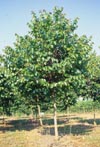Home > Tree selection > Uncommon trees zone 8-9 > Cercis canadensis
Cercis reniformis,
'Oklahoma' Oklahoma Redbud
`Oklahoma' Redbud should be grown in full sun or partial shade on moist, well-drained soil. This is one of the nicest (if not the nicest) redbuds and should be grown by the industry. The glossy leaves always draw attention to the tree even by those unconcerned about trees. It is highly drought tolerant once established and grows well in all areas within its hardiness range. Trees are doing well in Gainesville.
Although very drought tolerant, trees look best when they receive some irrigation in summer dry spells. The native habitat ranges from stream bank to dry ridge. Although a legume, nitrogen-fixing bacteria (rhizobia) have not been associated with the root system. Containerized and pre-dug trees can be planted anytime. Wood is considered ring porous.
This plant can be grown as a multi-trunk tree for use in highway median strips and in landscapes, or can be used as a street tree where there is not a need for tall-vehicle clearance beneath the crown. The small stature and low, spreading, branching habit makes pruning for vehicular clearance difficult unless it is properly trained from an early age to develop one main trunk. The effort required initially to train this tree for street tree use, however, may be offset by its advantages. It makes a great flower display, better than Cercis canadensis.
Prune to maintain a dominant leader (one main trunk) by cutting back or removing competing leaders. Do this every 2-3 years for the first 10 years after planting. Do not allow branches with included bark to grow too large because they could split from the tree. This is best accomplished by removing some secondary branches (especially those toward the edge of the canopy) along those branches with included bark. Regularly reduce the length of low aggressive branches by making reduction cuts if these branches will be in the way later and have to be removed. This will prevent having to make large pruning wounds later because the pruned branches will grow slower. Large pruning wounds can initiate decay in the trunk and branches, and decay can advance rapidly. Perform needed pruning after flowering in spring and early summer in order to enjoy the spring flowers.






